Accounting for Business Combinations at Ghastly Cemeteries Inc. (GCI)
VerifiedAdded on 2023/06/08
|6
|1195
|324
Case Study
AI Summary
This case study provides an analysis of the accounting treatment for business combinations, specifically focusing on Ghastly Cemeteries Inc. (GCI) and its acquisitions of Gengar Funeral Homes (GFH) and Dusclop Funeral Homes (DFH). It details the three-step process involved in accounting for business combinations, including gauging the purchase cost, ascertaining the fair values of assets and liabilities acquired, and assigning the cost based on fair values. The case study highlights the differences in accounting treatment between Accounting Standards for Private Enterprises (ASPE) and IFRS, particularly concerning the fair value of share consideration and liability recognition in relation to exit activities. It also discusses the journal entries required to record the acquisition of DFH shares, including the debit to investment in DFH’s stock account and the credit to cash account, as well as the accounting for dividends received and the share of income earned by DFH. The case concludes by examining the legal requirements for board representation in the context of the acquisition.
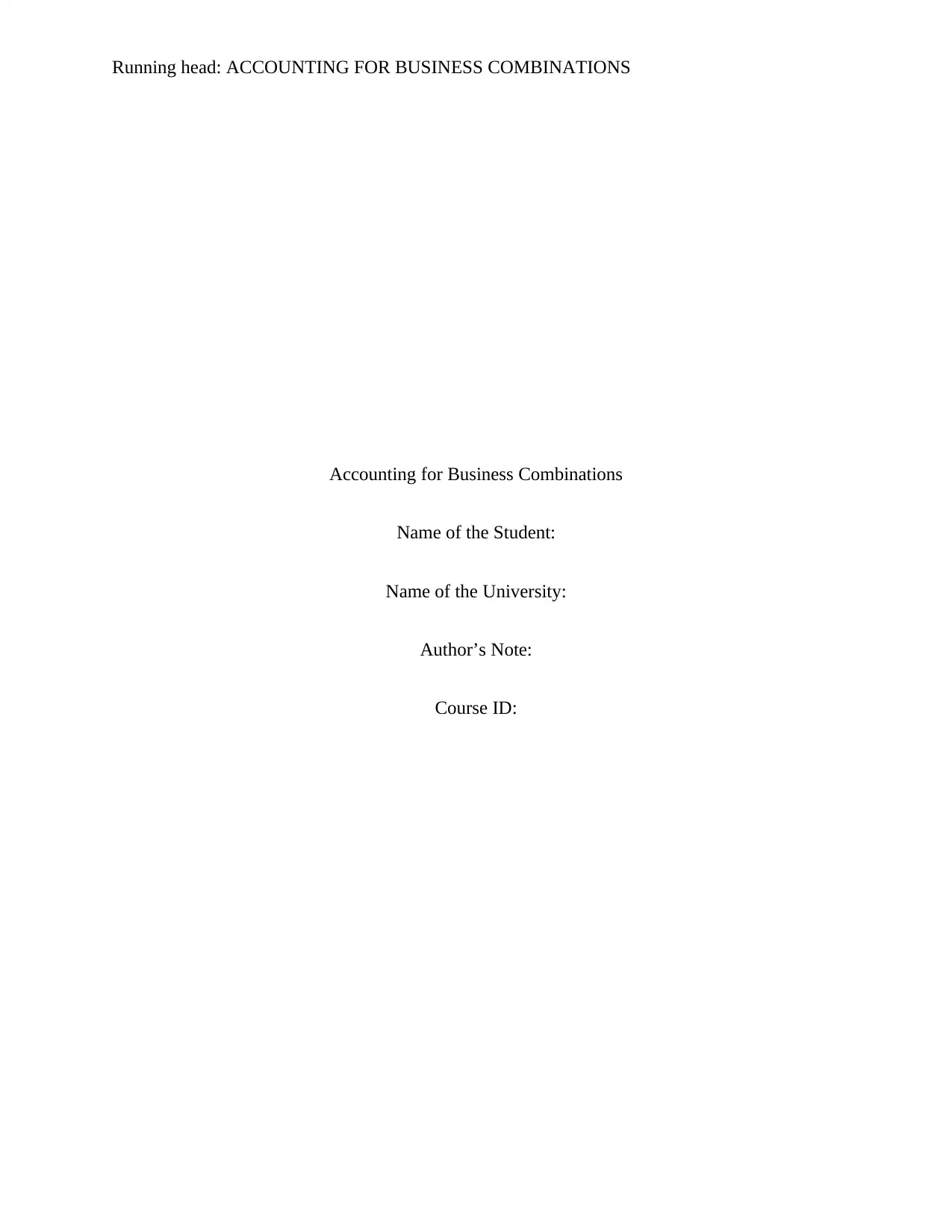
Running head: ACCOUNTING FOR BUSINESS COMBINATIONS
Accounting for Business Combinations
Name of the Student:
Name of the University:
Author’s Note:
Course ID:
Accounting for Business Combinations
Name of the Student:
Name of the University:
Author’s Note:
Course ID:
Paraphrase This Document
Need a fresh take? Get an instant paraphrase of this document with our AI Paraphraser
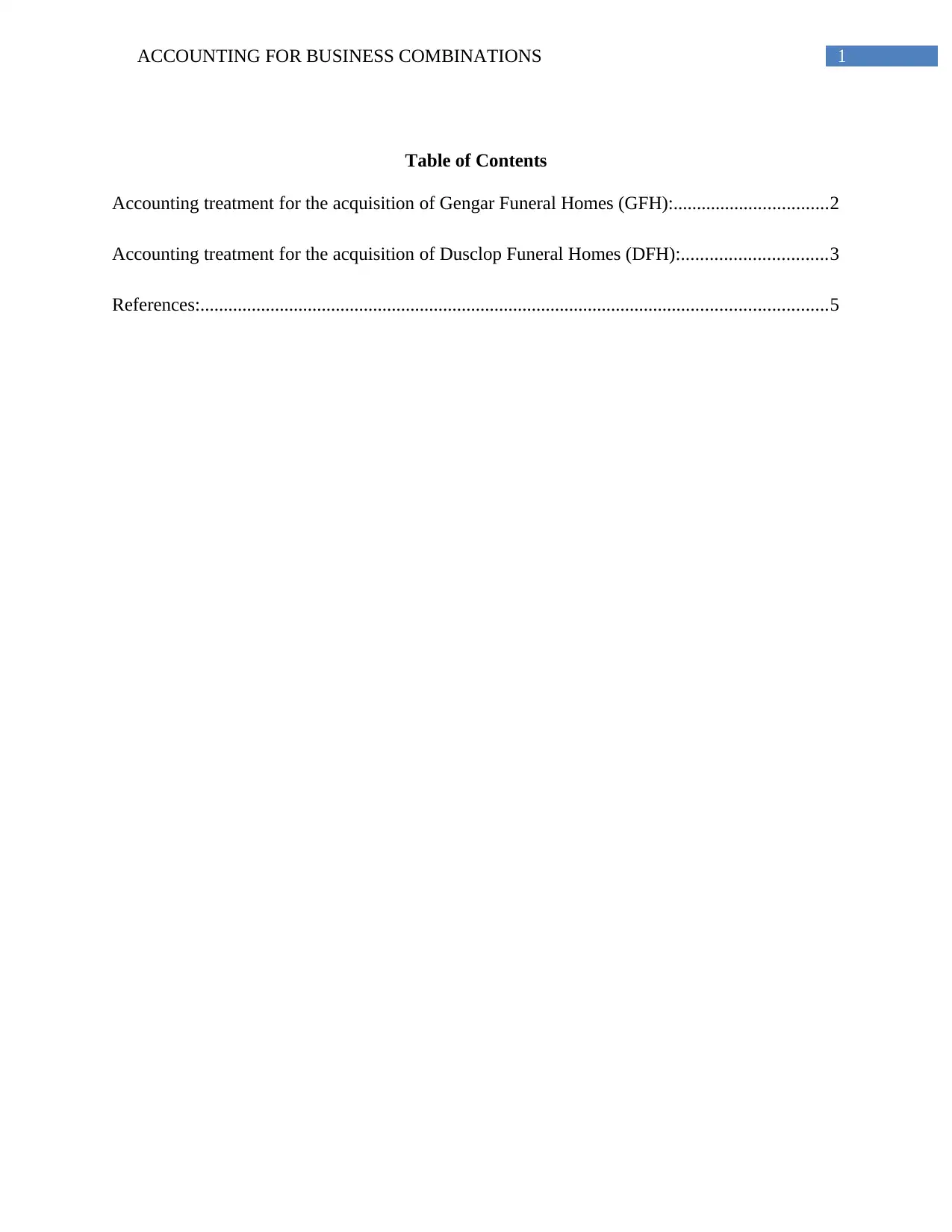
1ACCOUNTING FOR BUSINESS COMBINATIONS
Table of Contents
Accounting treatment for the acquisition of Gengar Funeral Homes (GFH):.................................2
Accounting treatment for the acquisition of Dusclop Funeral Homes (DFH):...............................3
References:......................................................................................................................................5
Table of Contents
Accounting treatment for the acquisition of Gengar Funeral Homes (GFH):.................................2
Accounting treatment for the acquisition of Dusclop Funeral Homes (DFH):...............................3
References:......................................................................................................................................5
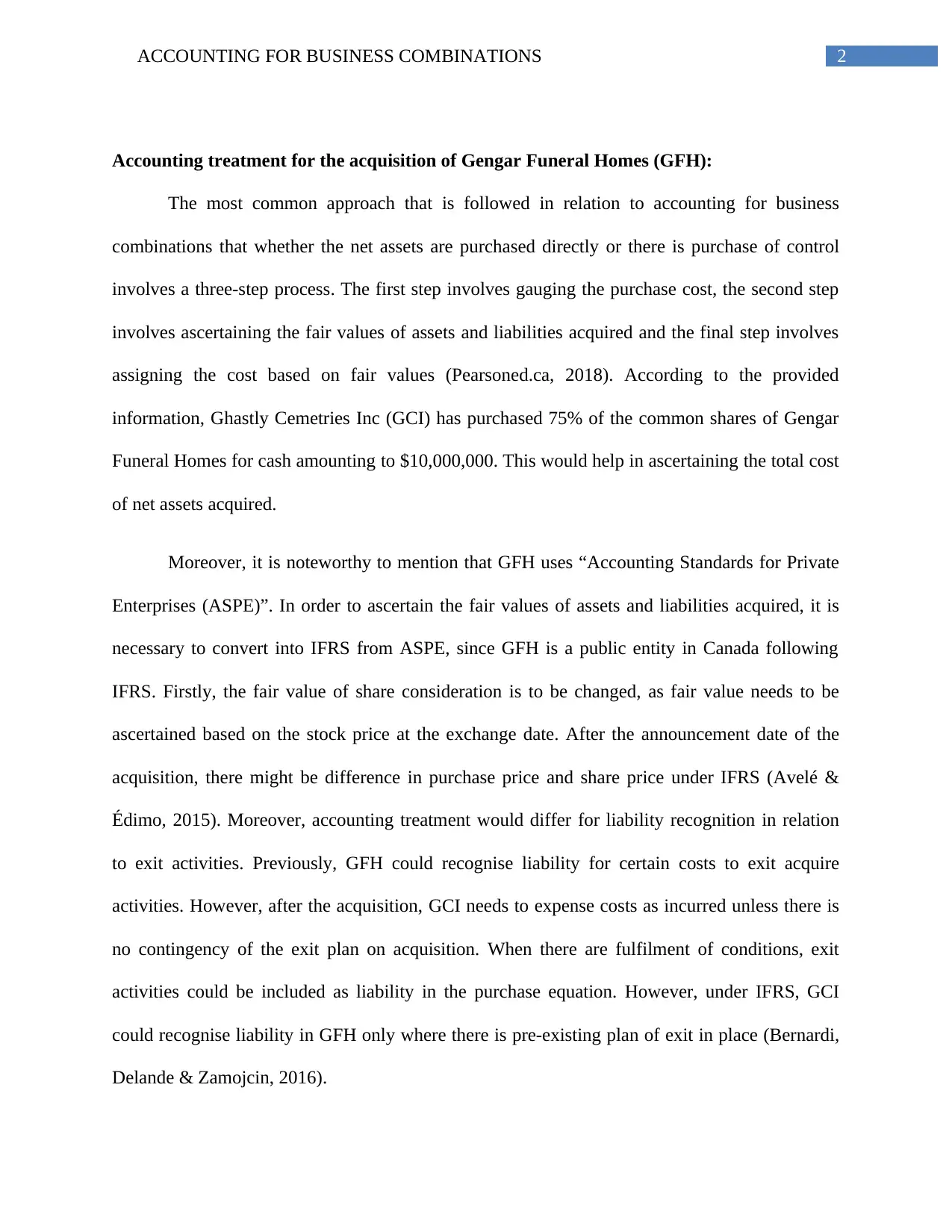
2ACCOUNTING FOR BUSINESS COMBINATIONS
Accounting treatment for the acquisition of Gengar Funeral Homes (GFH):
The most common approach that is followed in relation to accounting for business
combinations that whether the net assets are purchased directly or there is purchase of control
involves a three-step process. The first step involves gauging the purchase cost, the second step
involves ascertaining the fair values of assets and liabilities acquired and the final step involves
assigning the cost based on fair values (Pearsoned.ca, 2018). According to the provided
information, Ghastly Cemetries Inc (GCI) has purchased 75% of the common shares of Gengar
Funeral Homes for cash amounting to $10,000,000. This would help in ascertaining the total cost
of net assets acquired.
Moreover, it is noteworthy to mention that GFH uses “Accounting Standards for Private
Enterprises (ASPE)”. In order to ascertain the fair values of assets and liabilities acquired, it is
necessary to convert into IFRS from ASPE, since GFH is a public entity in Canada following
IFRS. Firstly, the fair value of share consideration is to be changed, as fair value needs to be
ascertained based on the stock price at the exchange date. After the announcement date of the
acquisition, there might be difference in purchase price and share price under IFRS (Avelé &
Édimo, 2015). Moreover, accounting treatment would differ for liability recognition in relation
to exit activities. Previously, GFH could recognise liability for certain costs to exit acquire
activities. However, after the acquisition, GCI needs to expense costs as incurred unless there is
no contingency of the exit plan on acquisition. When there are fulfilment of conditions, exit
activities could be included as liability in the purchase equation. However, under IFRS, GCI
could recognise liability in GFH only where there is pre-existing plan of exit in place (Bernardi,
Delande & Zamojcin, 2016).
Accounting treatment for the acquisition of Gengar Funeral Homes (GFH):
The most common approach that is followed in relation to accounting for business
combinations that whether the net assets are purchased directly or there is purchase of control
involves a three-step process. The first step involves gauging the purchase cost, the second step
involves ascertaining the fair values of assets and liabilities acquired and the final step involves
assigning the cost based on fair values (Pearsoned.ca, 2018). According to the provided
information, Ghastly Cemetries Inc (GCI) has purchased 75% of the common shares of Gengar
Funeral Homes for cash amounting to $10,000,000. This would help in ascertaining the total cost
of net assets acquired.
Moreover, it is noteworthy to mention that GFH uses “Accounting Standards for Private
Enterprises (ASPE)”. In order to ascertain the fair values of assets and liabilities acquired, it is
necessary to convert into IFRS from ASPE, since GFH is a public entity in Canada following
IFRS. Firstly, the fair value of share consideration is to be changed, as fair value needs to be
ascertained based on the stock price at the exchange date. After the announcement date of the
acquisition, there might be difference in purchase price and share price under IFRS (Avelé &
Édimo, 2015). Moreover, accounting treatment would differ for liability recognition in relation
to exit activities. Previously, GFH could recognise liability for certain costs to exit acquire
activities. However, after the acquisition, GCI needs to expense costs as incurred unless there is
no contingency of the exit plan on acquisition. When there are fulfilment of conditions, exit
activities could be included as liability in the purchase equation. However, under IFRS, GCI
could recognise liability in GFH only where there is pre-existing plan of exit in place (Bernardi,
Delande & Zamojcin, 2016).
⊘ This is a preview!⊘
Do you want full access?
Subscribe today to unlock all pages.

Trusted by 1+ million students worldwide
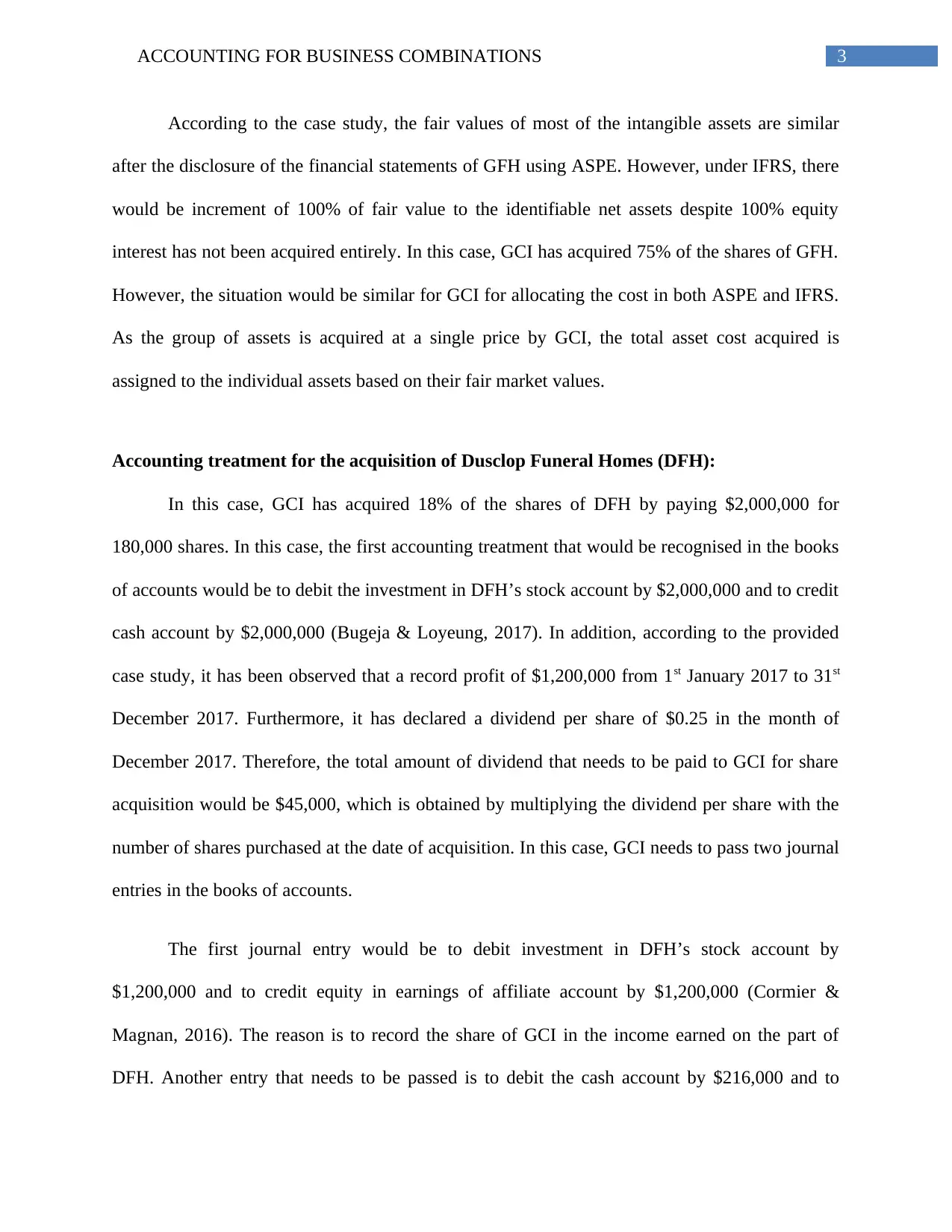
3ACCOUNTING FOR BUSINESS COMBINATIONS
According to the case study, the fair values of most of the intangible assets are similar
after the disclosure of the financial statements of GFH using ASPE. However, under IFRS, there
would be increment of 100% of fair value to the identifiable net assets despite 100% equity
interest has not been acquired entirely. In this case, GCI has acquired 75% of the shares of GFH.
However, the situation would be similar for GCI for allocating the cost in both ASPE and IFRS.
As the group of assets is acquired at a single price by GCI, the total asset cost acquired is
assigned to the individual assets based on their fair market values.
Accounting treatment for the acquisition of Dusclop Funeral Homes (DFH):
In this case, GCI has acquired 18% of the shares of DFH by paying $2,000,000 for
180,000 shares. In this case, the first accounting treatment that would be recognised in the books
of accounts would be to debit the investment in DFH’s stock account by $2,000,000 and to credit
cash account by $2,000,000 (Bugeja & Loyeung, 2017). In addition, according to the provided
case study, it has been observed that a record profit of $1,200,000 from 1st January 2017 to 31st
December 2017. Furthermore, it has declared a dividend per share of $0.25 in the month of
December 2017. Therefore, the total amount of dividend that needs to be paid to GCI for share
acquisition would be $45,000, which is obtained by multiplying the dividend per share with the
number of shares purchased at the date of acquisition. In this case, GCI needs to pass two journal
entries in the books of accounts.
The first journal entry would be to debit investment in DFH’s stock account by
$1,200,000 and to credit equity in earnings of affiliate account by $1,200,000 (Cormier &
Magnan, 2016). The reason is to record the share of GCI in the income earned on the part of
DFH. Another entry that needs to be passed is to debit the cash account by $216,000 and to
According to the case study, the fair values of most of the intangible assets are similar
after the disclosure of the financial statements of GFH using ASPE. However, under IFRS, there
would be increment of 100% of fair value to the identifiable net assets despite 100% equity
interest has not been acquired entirely. In this case, GCI has acquired 75% of the shares of GFH.
However, the situation would be similar for GCI for allocating the cost in both ASPE and IFRS.
As the group of assets is acquired at a single price by GCI, the total asset cost acquired is
assigned to the individual assets based on their fair market values.
Accounting treatment for the acquisition of Dusclop Funeral Homes (DFH):
In this case, GCI has acquired 18% of the shares of DFH by paying $2,000,000 for
180,000 shares. In this case, the first accounting treatment that would be recognised in the books
of accounts would be to debit the investment in DFH’s stock account by $2,000,000 and to credit
cash account by $2,000,000 (Bugeja & Loyeung, 2017). In addition, according to the provided
case study, it has been observed that a record profit of $1,200,000 from 1st January 2017 to 31st
December 2017. Furthermore, it has declared a dividend per share of $0.25 in the month of
December 2017. Therefore, the total amount of dividend that needs to be paid to GCI for share
acquisition would be $45,000, which is obtained by multiplying the dividend per share with the
number of shares purchased at the date of acquisition. In this case, GCI needs to pass two journal
entries in the books of accounts.
The first journal entry would be to debit investment in DFH’s stock account by
$1,200,000 and to credit equity in earnings of affiliate account by $1,200,000 (Cormier &
Magnan, 2016). The reason is to record the share of GCI in the income earned on the part of
DFH. Another entry that needs to be passed is to debit the cash account by $216,000 and to
Paraphrase This Document
Need a fresh take? Get an instant paraphrase of this document with our AI Paraphraser
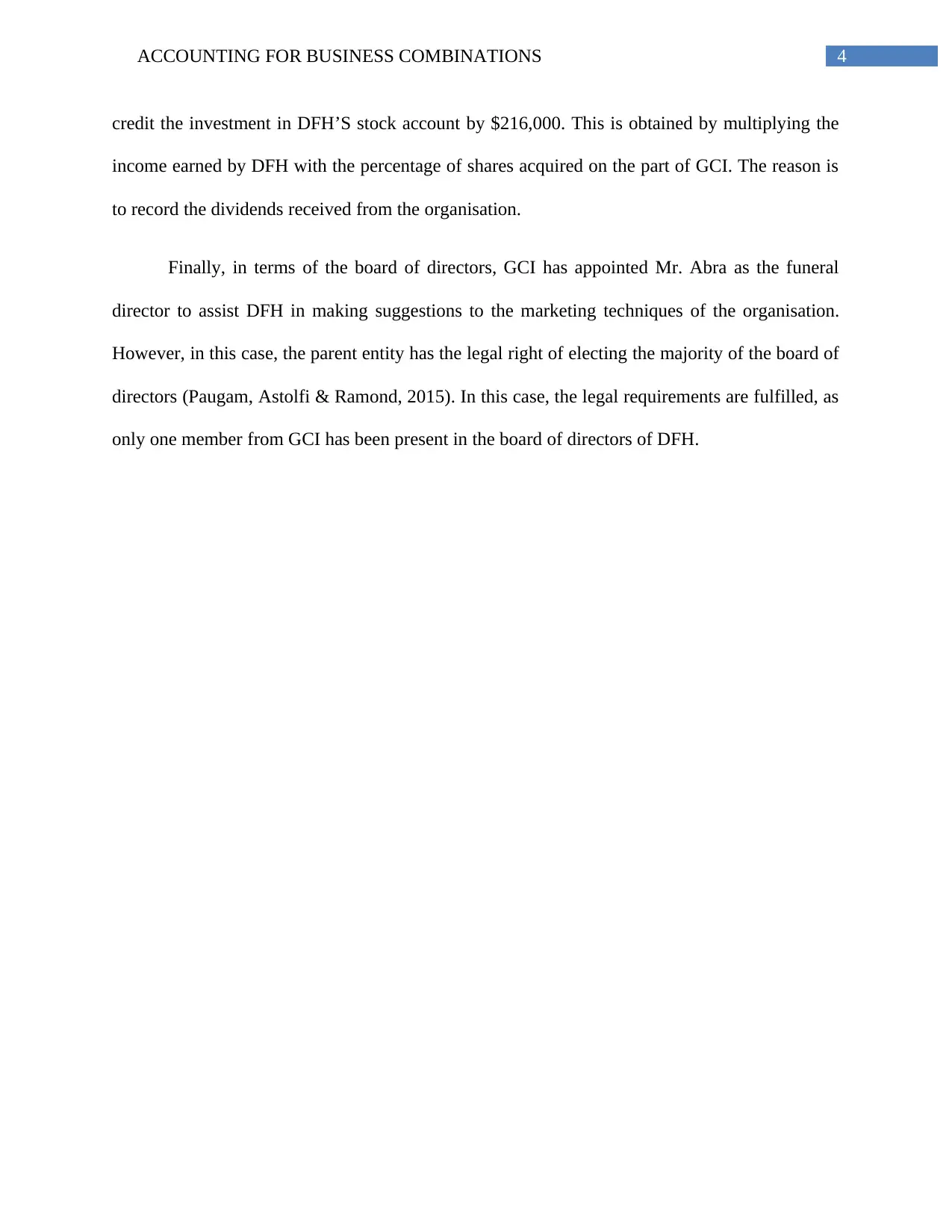
4ACCOUNTING FOR BUSINESS COMBINATIONS
credit the investment in DFH’S stock account by $216,000. This is obtained by multiplying the
income earned by DFH with the percentage of shares acquired on the part of GCI. The reason is
to record the dividends received from the organisation.
Finally, in terms of the board of directors, GCI has appointed Mr. Abra as the funeral
director to assist DFH in making suggestions to the marketing techniques of the organisation.
However, in this case, the parent entity has the legal right of electing the majority of the board of
directors (Paugam, Astolfi & Ramond, 2015). In this case, the legal requirements are fulfilled, as
only one member from GCI has been present in the board of directors of DFH.
credit the investment in DFH’S stock account by $216,000. This is obtained by multiplying the
income earned by DFH with the percentage of shares acquired on the part of GCI. The reason is
to record the dividends received from the organisation.
Finally, in terms of the board of directors, GCI has appointed Mr. Abra as the funeral
director to assist DFH in making suggestions to the marketing techniques of the organisation.
However, in this case, the parent entity has the legal right of electing the majority of the board of
directors (Paugam, Astolfi & Ramond, 2015). In this case, the legal requirements are fulfilled, as
only one member from GCI has been present in the board of directors of DFH.
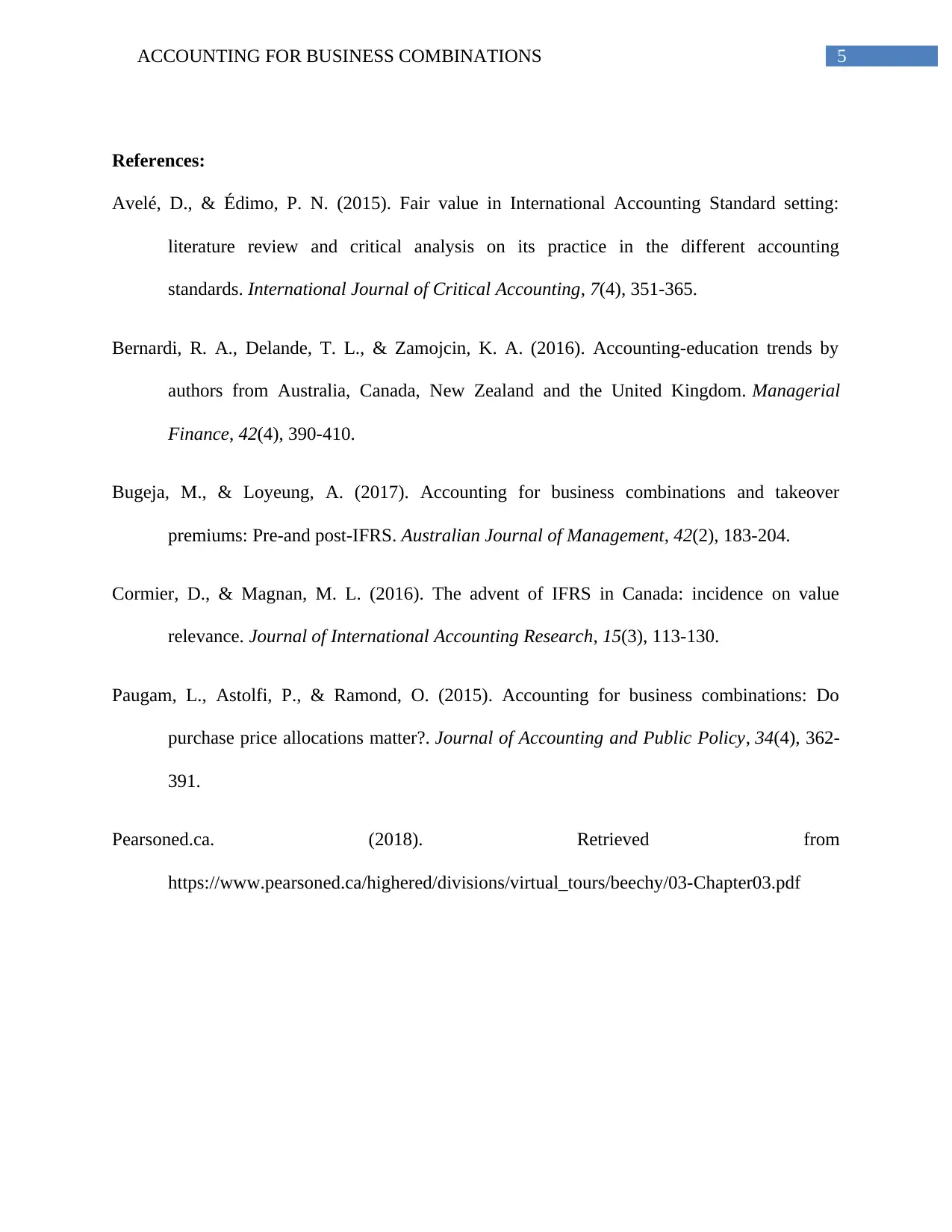
5ACCOUNTING FOR BUSINESS COMBINATIONS
References:
Avelé, D., & Édimo, P. N. (2015). Fair value in International Accounting Standard setting:
literature review and critical analysis on its practice in the different accounting
standards. International Journal of Critical Accounting, 7(4), 351-365.
Bernardi, R. A., Delande, T. L., & Zamojcin, K. A. (2016). Accounting-education trends by
authors from Australia, Canada, New Zealand and the United Kingdom. Managerial
Finance, 42(4), 390-410.
Bugeja, M., & Loyeung, A. (2017). Accounting for business combinations and takeover
premiums: Pre-and post-IFRS. Australian Journal of Management, 42(2), 183-204.
Cormier, D., & Magnan, M. L. (2016). The advent of IFRS in Canada: incidence on value
relevance. Journal of International Accounting Research, 15(3), 113-130.
Paugam, L., Astolfi, P., & Ramond, O. (2015). Accounting for business combinations: Do
purchase price allocations matter?. Journal of Accounting and Public Policy, 34(4), 362-
391.
Pearsoned.ca. (2018). Retrieved from
https://www.pearsoned.ca/highered/divisions/virtual_tours/beechy/03-Chapter03.pdf
References:
Avelé, D., & Édimo, P. N. (2015). Fair value in International Accounting Standard setting:
literature review and critical analysis on its practice in the different accounting
standards. International Journal of Critical Accounting, 7(4), 351-365.
Bernardi, R. A., Delande, T. L., & Zamojcin, K. A. (2016). Accounting-education trends by
authors from Australia, Canada, New Zealand and the United Kingdom. Managerial
Finance, 42(4), 390-410.
Bugeja, M., & Loyeung, A. (2017). Accounting for business combinations and takeover
premiums: Pre-and post-IFRS. Australian Journal of Management, 42(2), 183-204.
Cormier, D., & Magnan, M. L. (2016). The advent of IFRS in Canada: incidence on value
relevance. Journal of International Accounting Research, 15(3), 113-130.
Paugam, L., Astolfi, P., & Ramond, O. (2015). Accounting for business combinations: Do
purchase price allocations matter?. Journal of Accounting and Public Policy, 34(4), 362-
391.
Pearsoned.ca. (2018). Retrieved from
https://www.pearsoned.ca/highered/divisions/virtual_tours/beechy/03-Chapter03.pdf
⊘ This is a preview!⊘
Do you want full access?
Subscribe today to unlock all pages.

Trusted by 1+ million students worldwide
1 out of 6
Related Documents
Your All-in-One AI-Powered Toolkit for Academic Success.
+13062052269
info@desklib.com
Available 24*7 on WhatsApp / Email
![[object Object]](/_next/static/media/star-bottom.7253800d.svg)
Unlock your academic potential
Copyright © 2020–2025 A2Z Services. All Rights Reserved. Developed and managed by ZUCOL.





